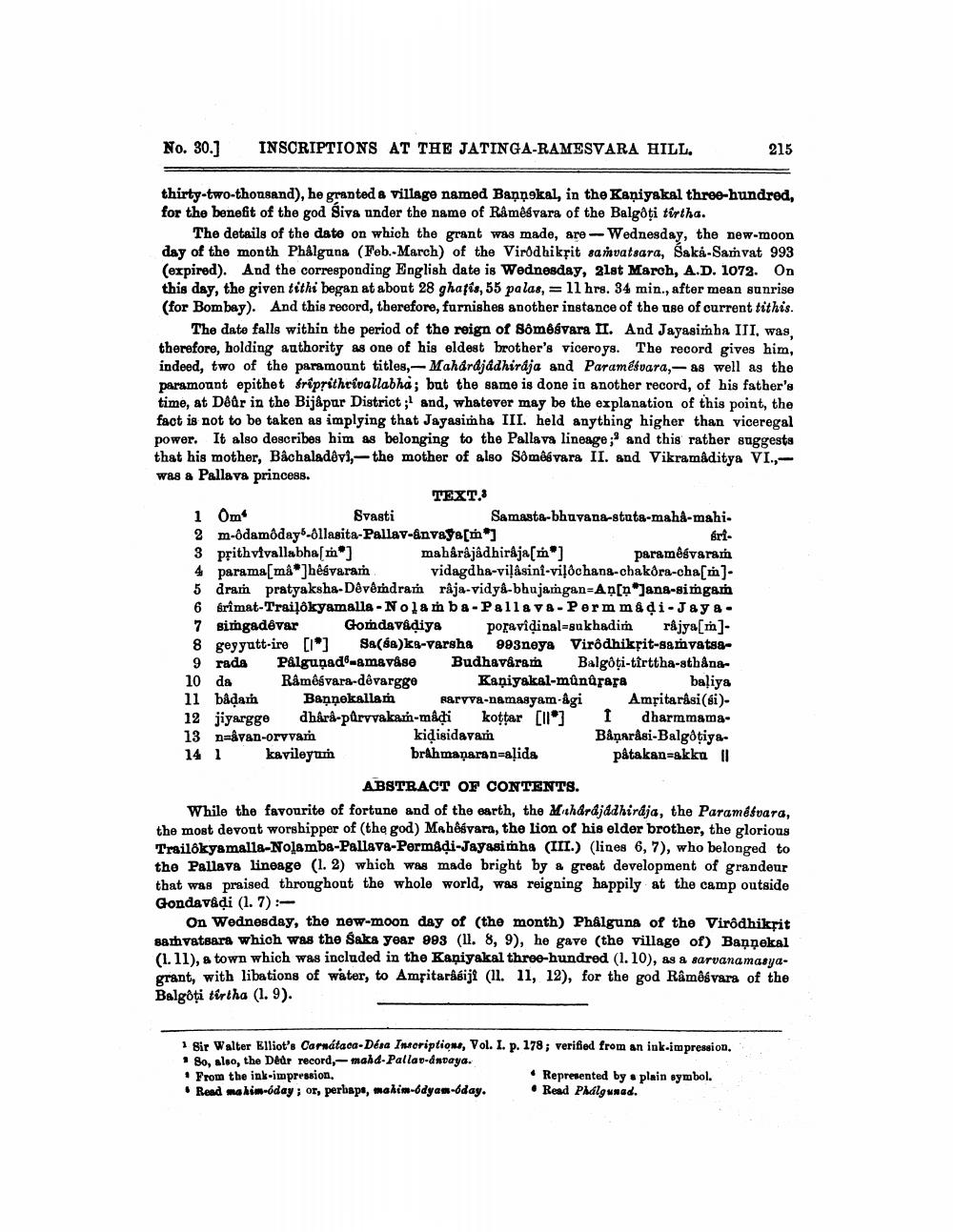________________
No. 30.]
INSCRIPTIONS AT THE JATINGA-RAMESVARA HILL,
215
thirty-two-thonsand), he granted a village named Baņņokal, in the Kaniyakal three-hundred, for the benefit of the god Siva under the name of Råmêsvara of the Balgoti tirtha.
The details of the date on which the grant was made, are-Wednesday, the new-moon day of the month Phålguna (Feb.-March) of the Virodhiksit sanvatsara, Saká-Samvat 993 (expired). And the corresponding English date is Wednesday, 21st March, A.D. 1072. On this day, the given tithi began at about 28 ghafís, 55 palas, = 11 hrs. 34 min., after mean sunrise (for Bombay). And this record, therefore, furnishes another instance of the use of current tithis.
The date falls within the period of the reign of 8ômégvara II. And Jayasimba III, was, therefore, holding authority as one of his eldest brother's viceroys. The record gives him, indeed, two of the paramount titles - Maharajadhiraja and Paramésvara, -as well as the paramount epithet fríprithrivallabha; bat the same is done in another record, of his father's time, at Dear in the Bijapur District ;' and, whatever may be the explanation of this point, the fact is not to be taken as implying that Jayasimha III. held anything higher than viceregal power. It also describes him as belonging to the Pallava lineage;" and this rather suggests that his mother, Bâchaladhvi,- the mother of also Sômêsvara II. and Vikramaditya VI.,was a Pallava princess.
TEXT. 1 Om
Svasti
Samasta-bhavana-stuta-mahi-mahi. 2 m-ôdamôday-Ollasita-Pallav-&nvaya[m]
eri. 3 prithvivallabha[m] mahârâjâdhiraja[m] paramèsvaram 4 parama[må*]hèsvaram vidagdha-viļâsini-viļôchana-chakðra-cha[m] 5 dram pratyaksha-Devendran raja-vidya-bhujamgan-An[p"Jana-simga 6 Srimat-Traiļôkyamalla - Nolan ba - Pallava-Permm&di-Jay & - 7 Bimgadevar G ondavidiya poraviļinal-sukhadim rajya[m]8 geyyutt-ire [19] Sa(se)ks-varsha 993neya Virôdhikṣit-samvatsa9 rada Pålguņado-amavåse Budhavaram Balgóti-tirttha-sthåna10 da Râmêsvara-dêvargge Kaņiyakal-munupara baliya 11 båda Bannekallam sarvva-namasyam-agi Amfitarasi(si)12 jiyargge dhårå-pûrvvakan-mađi kottar [ll] I dharmmama. 13 n=&van-orvvam
kiţisidavam
Baņaråsi-Balgotiye141 kavileyun
brahmaṇaran=aļida påtakan-akku 11
ABSTRACT OF CONTENTS. While the favourite of fortune and of the earth, the Mithdrdjadhirdja, the Paramétvara, the most devout worshipper of (the god) Mahêsvara, the lion of his elder brother, the glorious Trailokysmalls-Nolamba-Pallava-Permadi-Jayasimha (III.) (lines 6, 7), who belonged to the Pallava lineage (1.2) which was made bright by a great development of grandeur that was praised throughout the whole world, was reigning happily at the camp outside Gondavadi (1.7):
On Wednesday, the now-moon day of the month) Phalguna of the Virôdhikrit samvatsara which was the Saka year 993 (11. 8, 9), he gave (the village of) Bannekal (1. 11), a town which was included in the Kaņiyakal three-hundred (1.10), as a sarvanamasya. grant, with libations of water, to Amritarásiji (11. 11, 12), for the god Râmôgvara of the Balgôți tirtha (1.9).
1 Sir Walter Elliot's Carnátaca-Désa Inseriptions, Vol. I. p. 178; verified from an ink-impression, • so, also, the Déur record, - mahd-Pallav-dnvaya. From the ink-impression.
• Represented by plain symbol. . Read mahim-oday; or, perhap, mahim-6dgas-óday. Read Palgunad.




